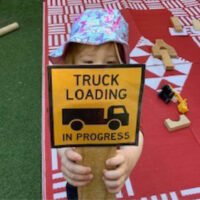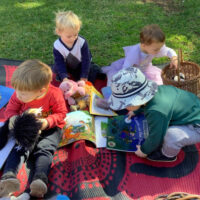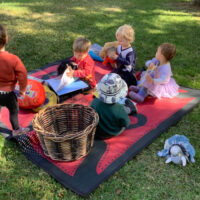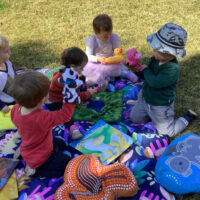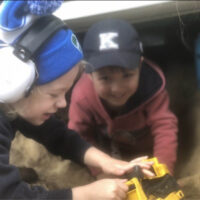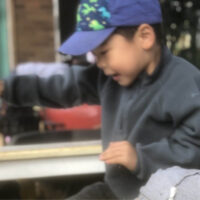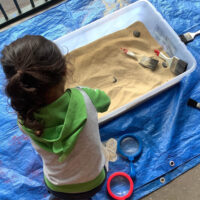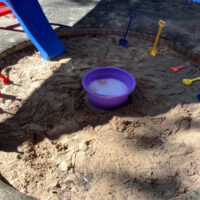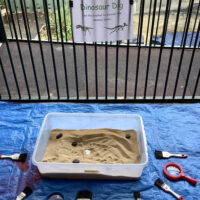Johnson House
Toddlers
Story by Educator Sreedevi
The children in Johnson House toddlers show a great interest in going out for walks to explore The Infants’ Home surroundings. We often see a variety of things to spark curiosity and conversations. Recently the children observed the traffic on Henry Street from one of the verandahs, and they loved spending time watching the cars and trucks going up and down the street. The children counted how many cars they could see, observed a crane with people cutting tree branches and noticed the road signs. This was a great opportunity to talk about the road signs and their meanings. The discussions and learning have been extended upon within the program, where we have continued to discuss road signs and have used creative arts to build on the children’s knowledge. We created traffic lights and used road signs in the block space to extend on this interest and learning experience.
Murray House
Toddlers
Story by Educator Rosie
To celebrate 2023 Book Week last week, some literacy resources were set up for the children and families at The Infants’ Home. The children in Murray House toddlers were invited to explore the various resources and activities, including books, puppets, visuals and playdough. They were excited while interacting with these, and they really enjoyed reading the book called ‘How the Birds Got Their Colours’, which is based on a traditional Aboriginal Dreamtime story. The children then created their own birds with different coloured playdough and feathers. This experience incorporated creative learning where the children used the knowledge that they had gained from the storybook and transferred it into the different setting of a creative learning experience, thus extending their learning while continuing to enhance their literacy skills.
Robinson House
Story by Educator Andrew
Today in Robinson House we embarked on a huge STEAM (science, technology, engineering, arts and mathematics) project in the sandpit. We have been working hard on tunnelling using shovels of late, and today we decided to take this project to the next level! The excavation project began with a group of children collaborating enthusiastically to construct an intricate tunnel system within the sandpit. I offered assistance, using a bigger shovel, and was happy to be the labourer for the job, following the guidance of the enthusiastic group of foremen. We all displayed remarkable creativity and resourcefulness, utilising a variety of materials such as pipes, tables, crates, and other loose parts to create a strong and safe structure that enabled the children to travel through the tunnel.
This project was a great opportunity to foster our imaginations, and our cooperation and communication skills and to enhance our motor skills as we manoeuvred our bodies through the tunnel. Safety was something we needed to maintain throughout the project, and it was wonderful to observe the children following the established rules so that we could all safely enjoy the experience. Not climbing on top of the structure and following the same path through the tunnel ensured just this.
The project was an incredible example of teamwork, as the children worked collaboratively to bring their vision to life. We saw joint efforts, effective communication, and problem-solving skills, and we also saw the children welcome others who hadn’t helped along the way to share their finished project. Great work Robinson House!
Community Plyagroups
Story by Playgroup Coordinator Rebecca
At playgroup we always have some kind of sand play available for the children. Whether the sand is in a small tray, sandpit or even at the beach, having the opportunity to play with sand is not only fun for your child but also provides them with opportunities to learn, discover and develop. There are numerous ways that sand play aids in the development of a child’s skills.
Using small shovels, pushing trucks, using brushes and pouring the sand are some of the ways that sand play helps to develop and strengthen your child’s fine motor skills. Large shovels, rakes and bigger trucks, and moving around the sand, requires the use of a child’s larger muscles to play.
Sand play can be independent, where the child plays by themselves, supported by a parent or carer who plays and interacts with them, or it can be a social activity where children work together or with an adult to achieve a common goal such as building a castle, making a road or rescuing the dinosaurs. The opportunities for imaginative play are endless.
This leads to the development of language and social skills as children communicate their ideas and learn to listen to others. Sharing and turn taking become easier with practice, and sand play is the perfect activity for this.
Sand is often a new and different texture for children to feel on their skin and it can sometimes feel a bit uncomfortable for both children and adults. Sand can be rough, cold, soft, hard and grainy. However, encouraging your child to experience new textures also provides an opportunity to introduce new words, for example, when comparing and contrasting the texture of the sand with other things such as wood, concrete, grass and dirt.

